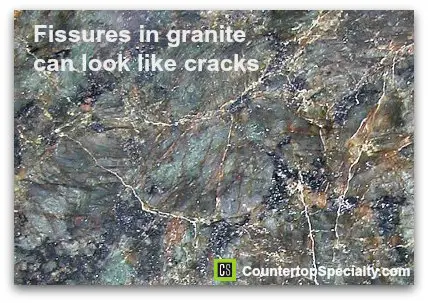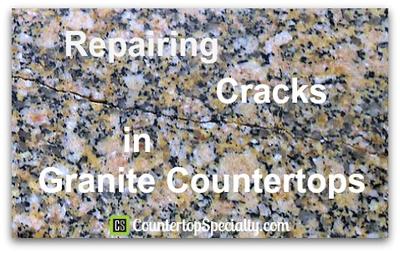How to Repair Cracks in Granite Countertops
QUESTION:
We just recently had 2 cm Santa Cecilia granite countertops installed.We found a crack in the granite in the corner. The crack goes from one wall of the corner to the other.
Not too noticeable, but we are concerned about any additional problems it might cause.
My husband also realized that there is no plywood support underneath the countertops, which really raises more concern for us at this point.
Could the lack of plywood support be the reason for this crack and should we insist that they come back and reinstall with plywood?
ANSWER:
Certainly you should have the installers return to assess the damage and, if needed, mend the granite crack. Although, your installer may not be the best one for the job.There are two types of granite cracks:
Hairline cracks typically cannot be seen or even felt easily, do not have a lip, and no gap or separation of the crack.
A hairline crack can occur during installation as the extremely heavy and rigid slab is moved into place. Typically, such cracks happen around sinks or other cutouts with thin sections of granite.
Naturally, many homeowners want the cracked slab replaced. But it can happen even with the most careful installation and there’s no guarantee it won’t happen with the replacement slab.
Hairline cracks generally do not need repair, will not get worse, and do not affect the use, cleaning, or integrity of the countertop. In some cases, additional support in the area could be beneficial.
Separated cracks have a gap, are easily seen and felt, and have a lip.
Separated cracks happen from a heavy impact, standing on the granite countertop, or foundation movement and require repair.
Granite Crack Repair Options
An experienced granite repair specialist is preferred for cracks in granite, marble, or any natural stone.
The typical granite installer is not experienced enough to artfully repair a crack in granite.
You'll end up with an ugly scar filled with epoxy. Installers can do minor repairs, but granite crack repair is a major repair (with a separated crack).
A person who has made crack repairs before knows the products and methods required and won't be experimenting or learning as they go.
Cracks in granite are repaired first by filling with acrylic or using a color-matched epoxy to glue the pieces back together. The choice here depends on the nature and severity of the crack.
Either way, the crack will remain easily visible and palpable unless the surface is then re-polished.
Filling or gluing the crack together could be a DIY job or something your installer could do, however, re-finishing the surface definitely is not a DIY project.
Polishing granite cracks to remove the edges of the crack and knowing how to blend the crack itself with the surrounding surface color and shine requires experience, knowledge, and skill.
This is why you want an experienced granite counter repair pro. Most fabricators / installers focus on installing and not repairing.
Luckily, since it's in the corner, even a mediocre repair won't be very noticeable and isn't a structural issue.
Doing nothing is also an option. When the crack in a granite countertop is only a short, hairline crack it rarely presents any real problems or gets worse. If it does, then you have it repaired.
It may not be worth the expense and hassle to repair a single, short, or surface hairline crack even
Small cracks usually don't pose any cleaning issues, and stains are rarely a problem, but applying a little extra sealer over a crack isn't a bad idea.
Long or full-thickness cracks and/or areas with multiple cracks likely need repair by a professional.
Granite Crack vs. Fissure
Any discussion of cracks in granite countertops must also include an explanation of fissures.
Fissures in granite are a natural characteristic of the stone.
Fissures are lines formed in the pattern of the stone by the borders of various crystalline groups within the stone.
 |
Fissures can be short or long... wide or narrow... only in the surface or full thickness... or may run through the countertop edges.
Many granite countertop colors don't have any fissures, others just a few and some patterns have many running all over.
Fissures are similar to cracks. In fact, you could say a fissure is a naturally occurring "crack" and sometimes can even look nearly identical to a crack.
The key difference of a fissure vs. a crack is separation.
- Fissures maintain structural integrity of the stone. No separation or space exists. It's a crack that hasn't actually cracked or split.
- Fissures occur across the slab... not just in one or two spots.
- Fissures are level, feel smooth and do not have an edge.
- Fissures are typically curved and do not run in straight lines or have angular zig-zags, but sometimes look like cracks.
 |
Fissures are weak points and can become a "crack" from impact or stressful forces during transportation, installation or after.
- Cracks are lines of physical separation. The stone has split.
- Cracks have an edge you can feel or catch with a fingernail.
- Cracks in granite are most commonly "hairline", but can be wider.
- Cracks can be short, long, surface or full-thickness of the slab.
- Cracks typically occur at sink and cooktop cutouts, edges and corners.
Plywood Support for Granite Countertops
Most/all granite slab countertops are installed right onto the cabinets without a plywood substrate. This is normal and provides plenty of support.
A tile countertop would need the plywood or backer board underlayment, but it's unnecessary for a slab countertop. Of course, you should not stand on granite countertops and be mindful to follow granite care guidelines.
I don't think the supposed "lack" of support had anything to do with the cracked granite.
A plywood substrate is sometimes used to create a level surface when cabinets/floors are not level. Or to elevate the kitchen countertop when a laminated edge is used, which helps keep the edge from interfering with the drawers.
The cracked corner probably occurred during moving and installing the granite counter top slab.
Slabs are big, heavy and difficult to move... can get some accidents.
Yes, I know you didn't pay for a cracked corner, but is it really worth the hassle to replace it?
If it was an edge or in an obviously visible area, then it may have to be redone. But it can likely be repaired reasonably.
And if in a back corner, you simply won't notice it that much (if at all). Possibly you can put some appliance or other decoration there as well.
Contact your installer or a granite repair specialist and see what is needed to fix the cracked corner. But you may decide just to leave it. If it's a hairline crack with minimal lip, it likely won't get worse or cause any future problem.
Comments for How to Repair Cracks in Granite Countertops
|
||
|
||
|
||
|
||
|
||
|
||
|
||
|
||
|
||
|
||
|
||
|
||
|
||
|
||
|
||
|
Click here to add your own comments Return to Granite Counter Top Maintenance Questions & Answers. |
Granite Countertop Crack at Sink Corner
by Barbara
(Portland, OR)
QUESTION:
Uba Tuba granite countertop. The top is 11 months, 3 weeks old.There is a crack at the corner of the sink.
I don't know how it happened...no one has confessed to causing it. Should this be covered by the warranty?
Could this have been caused by the undermount sink not being installed correctly?
ANSWER:
Cut outs for sinks and cooktops are weak points and the most likely spots for cracks in granite to occur.The sink area receives a lot of abuse. A crack could develop from direct impact, someone sitting or standing on the countertop, or stress from using the sink.
Yes... it also could have happened during installation of the granite countertop.
Usually this happens simply because a granite slab is extremely heavy and difficult to maneuver. Despite all best efforts and care sometimes a crack develops in weaker areas.
If a major crack occurs during install any reputable fabricator will, repair the crack, cut out and replace the area if possible or simply eat the cost and start over.
But if only a hairline crack it may go unnoticed or even when noticed installed anyway because these are almost never a problem, will remain stable and do not affect the performance of the counter top.
Highly unlikely it developed because the sink was installed "incorrectly". Not much to screw up with that.
However, eleven months after install it's impossible to tell if the installers are somehow to blame, so not really fair or productive to accuse them at this point.
And it may be nothing to worry about. If the crack can only be felt by running your finger tip or fingernail over it and there isn't any lip, then it probably won't be an issue.
However, if the crack has a lip and/or it looks to go all the way through the entire slab, then you may have an issue and it could get worse, especially around the sink.
Cracks in granite countertops around the sink most often are just hairline cracks without a lip and never really present a problem other than a bit of frustration that it exists.
Possibly a simple repair or extra support could be added to stabilize the area. Check with your installer.
Of course, you can't expect them to do this for free since there's no way at this point to fault them for it.
If there is a lip, you may still be able to level the surface, repair and stabilize the area to eliminate any problem. This will require professional granite repair of course.
Worst case scenario is replacement of a part or the entire granite counter top, but almost never needed.
Comments for Granite Countertop Crack at Sink Corner
|
||
|
||
|
Click here to add your own comments Return to Granite Counter Top Maintenance Questions & Answers. |
Hairline Cracks in New Granite
by Donna
(Philadelphia)
QUESTION:
We have just installed new granite countertop.The cutout for the stove top was too small, but the installer shoved the stove top into the space.
Now there are hairline cracks radiating out from three of the four corners of the cook top hole and the stove top is broken.
One of them goes all the way through the slab. The others seem to be on the surface.
Should we make them replace the granite countertop? They haven't even hooked up sink or stove top yet. They claim epoxy will solve the problem.
ANSWER:
I'd make them replace the granite. Considering they couldn't think ahead or be patient enough to do the job right, I wouldn't trust any countertop repair job they were going to attempt.A single hairline crack somewhere, I wouldn't worry about, but multiple cracks radiating from 3 corners of the cook top cut-out... no good.
You will be constantly stressing this area too with additional weight and pots and pans banging around (if you cook like me anyway!).
Plus, with so many cracks concentrated in small areas, they may get worse with more becoming full thickness.
True, epoxy or polyester resin could repair the cracked granite and improve the integrity in the area, but cut-outs are weak areas.
Even with repair and any support that they may be able to add the entire area is compromised.
Epoxy can be very strong and a stellar repair may be sufficient, but I'd want a granite repair specialist to do it.
Now, I don't know how long or how many cracks there are, so maybe it sounds worse than it is and you're thinking maybe just to negotiate a much cheaper price and an adequate repair.
That's an option...
However, there is still the issue of the broken cook top.
You need a new one... the same one won't fit this cut out. So, you need one that will fit this cut out because enlarging the cut out now is risky... could wreck the slab.
Maybe you get lucky and find one, but this is a bassackwards way of doing it.
I say start over.
Comments for Hairline Cracks in New Granite
|
||
|
||
|
||
|
||
|
||
|
||
|
||
|
||
|
||
|
||
|
||
|
Click here to add your own comments Return to Granite Counter Top Maintenance Questions & Answers. |





